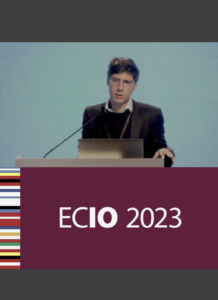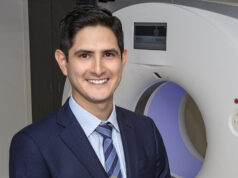
Two of the sessions from day one of the 2023 European Conference on Interventional Oncology (ECIO; 16–19 April, Stockholm, Sweden) drew delegates’ focus to what the evidence in interventional oncology (IO) and immuno-oncology is indicating in 2023. Specifically, hepatocellular carcinoma (HCC) featured as the subject of presentations—the promise of locoregional and immunotherapy in tandem for advanced HCC among them. On the immuno-oncology side, the audience was privy to an examination of the potential role IO can play in treating oligoprogression and oligoresistance.
A key takeaway from the presentations in question was that there will always be a need to consider different types of tumour and different patients in different ways—homogeneity will not yield desired outcomes—and therefore, the continued pursuit for more evidence is crucial.
Bruno Sangro (Clínica Universidad de Navarra, Madrid, Spain) was among the speakers who addressed advanced HCC evidence, beginning by outlining that “one of the main reasons why, twenty years ago, we were doing locoregional therapies for everyone, even for patients with metastases [is that] we had nothing else to offer patients with advanced tumours”. Sangro then turned to address combining locoregional therapies with immunotherapy: “We have two drug combinations that are able, no question, to improve the survival of patients in the advanced stage. We started from a point where we were able to improve survival for the majority of patients—when it comes to three-year survival rate, we were able to get 15–20% of patients alive at that time. Now these figures have doubled.”
The benefit of checkpoint inhibitors
A discovery that changed the field, according to Sangro, were checkpoints inhibitors—”unlike with tyrosine kinase inhibitors (TKIs), these treatments can induce responses irrespective of tumour location or burden, [whether] small tumours, large tumours, [those] invading the portal vein, metastases. The most important point is that patients who respond, have a very prolonged survival.” Expanding further on his experience, Sangro shared that “when we looked at checkpoint inhibitors versus TKIs as a first-line therapy, consistently we were able to see that single agents were able to increase the number of long-term survivals but were not able to significantly improve the overall survival of the population”.
The promise of systemic therapy
Sangro went on to explain that “because of the success of immunotherapy in the advanced stage, more patients in earlier stages of the disease are reaching systemic therapy [and are] no longer kept on repeated locoregional therapies. Now, all poor candidates for selective transarterial chemoembolization (TACE) or transarterial radioembolization (TARE) are being moved onto systemic therapies, increasing their survival.” This led Sangro to underline what one of the key messages from his presentation is—overall, the survival of patients treated with systemic therapy is improving. This improvement, the speaker supplemented, is seen in tolerability, and in terms of patient-reported outcomes, including quality of life. The next step, Sangro stated, is to make the most of “the opportunity to test whether [systemic therapy] improves the outcomes and survival for other earlier [HCC] stages”.
Providing a counterpoint, the presenter pointed to other tumour types, and the fact that where there are good systemic therapies for patients with these, this also “has to be translated into early-and intermediate-stage patients otherwise, as it happened with TKIs, it would not be the kind of systemic therapies we would like to have.” This was echoed in the question and answer session that followed Lambros Tselikas’ (Institut Gustave Roussy, Villejuif, France) presentation by Antonia Digklia (Centre hospitalier universitaire de Lausanne, Lausanne, Switzerland), who emphasised to the audience the importance of focusing on each tumour subject across IO.
Distinguishing oligoresistance from oligoprogression
Tselikas began his presentation by defining oligoresistance, which means that “you only have control of some of the lesions”. Some lesions may also have primary resistance to immunotherapies, Tselikas elaborated—even though it is the same disease, it is a different immune microenvironment surrounding the different tumours. Oligoprogression, in distinction is when some of the multiple lesions “regrow or recur in other places”. This, therefore, constitutes secondary resistance, which is a “completely different scenario”.
Whether a patient’s cancer is oligoresistant or oligoprogressive can “impact on the results you expect,” Tselikas averred, explaining that in the case of the former, “you hope to be curative”. However, with the latter, “you delay the resistance, and it can last for a while”.
The question of how and whether to treat
The next question is then how you treat the two types of oligometastases. In the case of oligoresistance, there is some evidence of ablation and radiation’s efficacy, but “this can be variable,” Tselikas acknowledged. In the case of oligoprogressive lesions that follow initial treatment, the presenter expressed doubts as to whether there is benefit to treating them, from an increased toxicity point of view. “We do not really know if there is any added value in local treatments [for these lesions], such as ablation, or radiation therapy,” Tselikas added, while pointing out that “oligoprogression under immunotherapy is quite rare, [but] it is very frequent under TKIs”.
The speaker went on to share his experience from his centre, where they have had eight patients over last 10 years who were treated with immunotherapies and received ablation treatment. “We have both [oligo]resistant and progressive,” Tselikas informed delegates—some [received] cryoablation, some radiofrequency ablation, and some microwave, and safety is perfect”. Regarding efficacy, the presenter observed better results for the patients with an oligoresistance profile, he shared.
Concluding, Tselikas noted the importance of “real-time, easy-to-obtain biomarkers […] for those to whom we can offer local treatments”. This will facilitate the idea that “IO can help immuno-oncology to help overcome these oligoresistance and oligoprogressive patterns,” as Tselikas sees it.










